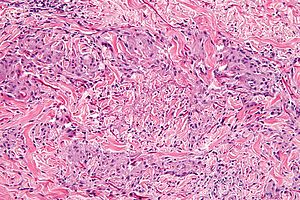Granuloma annulare
Jump to navigation
Jump to search
Granuloma annulare is relatively uncommon problem in dermatopathology.
| Granuloma annulare | |
|---|---|
| Diagnosis in short | |
 Granuloma annulare. H&E stain. | |
|
| |
| LM | Palisading granulomas around necrobiotic collagen and mucin |
| Subtypes | superficial (common), deep (not common) |
| LM DDx | rheumatoid nodule, necrobiosis lipoidica, epithelioid sarcoma |
| Stains | alcian blue stain (pH 2.5) |
| Gross | usu. arms and hands, papules |
| Site | skin - esp. antecubital fossae |
|
| |
| Prognosis | benign |
General
- Benign and self-limited condition.
- Etiology unknown - may be assoc. with trauma.[1]
- Associations: trauma, infections, diabetes mellitus, dyslipidemia, thyroid disease, malignancy, medications.[2]
- A deep GA can mimic a rheumatoid nodule; may be called a pseudorheumatoid nodule.[3]
Gross
- Typically extremities - usu. arms and hands.[1]
Image
Gross
- Antecubital fossae.[2]
Microscopic
Features:[4]
- Dermal palisading granuloma - typically superficial-to-mid dermis - surrounds:
- Necrotic collagen - key feature.
- Nuclei "missing" - have undergone karyolysis.
- Mucin - important.
- Loose/pale, paucicellular, eosinophilic.
- Necrotic collagen - key feature.
- Chronic inflammatory cells.
Notes:
- There may be multiple small foci with intervening normal dermis.[1]
- Granuloma annulare can be subclassified into subcutaneous and interstitial.
- Histomorphologically similar to Rheumatoid nodule.
- Neutrophils may be seen.[5]
DDx:
- Necrobiosis lipoidica - little mucin, no normal dermis between foci,[1] plasma cells - common,[6] may involve the fat - tend to be deeper.
- Rheumatoid nodule - has fibrin in the core of the granuloma (instead of mucin), multinucleated macrophages more common.[7]
- Epithelioid sarcoma - esp. if the lesion appears to be mid-to-deep dermis.
- Tattoo reaction (granuloma annulare-like) - case report.[8]
Images
www:
Stains
- Alcian blue (pH 2.5) +ve (for mucin).[9][1]
Image:
IHC
Note:
- Not routinely used.
Sign out
SKIN LESION, UPPER BACK, PUNCH BIOPSY: - SUPERFICIAL PALISADING GRANULOMAS WITH CORES OF NECROBIOTIC COLLAGEN, AND SCANT MUCIN; CONSISTENT WITH GRANULOMA ANNULARE.
Skin lesion, left elbow, excision: - Palisading granulomas with cores of necrobiotic collagen, and scant mucin consistent with granuloma annulare. COMMENT: An alcian-blue stain (pH 2.5) shows scant mucin. The granulomas are relatively deep; however, plasma cells are not apparent. The differential diagnosis is rheumatoid nodule.
Micro
The sections show hair bearing skin with superficial palisading granuloma with cores of necrobiotic collagen and mucin. Plasma cells are not apparent in association with the lesion.
The overlying epidermis matures normally to the surface and has no basal atypia.
See also
References
- ↑ 1.0 1.1 1.2 1.3 1.4 Busam, Klaus J. (2009). Dermatopathology: A Volume in the Foundations in Diagnostic Pathology Series (1st ed.). Saunders. pp. 51. ISBN 978-0443066542.
- ↑ 2.0 2.1 Fox JD, Aramin H, Ghiam N, Freedman JB, Romanelli P (August 2020). "Secukinumab-associated localized granuloma annulare (SAGA): a case report and review of the literature". Dermatol Online J 26 (8). PMID 32941717.
- ↑ Barzilai, A.; Huszar, M.; Shpiro, D.; Nass, D.; Trau, H. (Feb 2005). "Pseudorheumatoid nodules in adults: a juxta-articular form of nodular granuloma annulare.". Am J Dermatopathol 27 (1): 1-5. PMID 15677968.
- ↑ Humphrey, Peter A; Dehner, Louis P; Pfeifer, John D (2008). The Washington Manual of Surgical Pathology (1st ed.). Lippincott Williams & Wilkins. pp. 478. ISBN 978-0781765275.
- ↑ Requena, L.; Fernández-Figueras, MT. (Jun 2007). "Subcutaneous granuloma annulare.". Semin Cutan Med Surg 26 (2): 96-9. doi:10.1016/j.sder.2007.02.006. PMID 17544961.
- ↑ URL: http://dermnetnz.org/pathology/necrobiosis-lipoidica-path.html. Accessed on: 24 January 2012.
- ↑ Busam, Klaus J. (2009). Dermatopathology: A Volume in the Foundations in Diagnostic Pathology Series (1st ed.). Saunders. pp. 52-3. ISBN 978-0443066542.
- ↑ Bagwan, IN.; Walker, M.; Theaker, JM. (Oct 2007). "Granuloma annulare-like tattoo reaction.". J Cutan Pathol 34 (10): 804-5. doi:10.1111/j.1600-0560.2006.00666.x. PMID 17880589.
- ↑ 9.0 9.1 Yun, JH.; Lee, JY.; Kim, MK.; Seo, YJ.; Kim, MH.; Cho, KH.; Kim, MB.; Lee, WS. et al. (May 2009). "Clinical and pathological features of generalized granuloma annulare with their correlation: a retrospective multicenter study in Korea.". Ann Dermatol 21 (2): 113-9. doi:10.5021/ad.2009.21.2.113. PMC 2861218. PMID 20523767. https://www.ncbi.nlm.nih.gov/pmc/articles/PMC2861218/.
- ↑ Töröcsik, D.; Bárdos, H.; Nagy, L.; Adány, R. (Sep 2005). "Identification of factor XIII-A as a marker of alternative macrophage activation.". Cell Mol Life Sci 62 (18): 2132-9. doi:10.1007/s00018-005-5242-9. PMID 16132226.
- ↑ Adány, R.; Bárdos, H.; Antal, M.; Módis, L.; Sárváry, A.; Szücs, S.; Balogh, I. (May 2001). "Factor XIII of blood coagulation as a nuclear crosslinking enzyme.". Thromb Haemost 85 (5): 845-51. PMID 11372678.